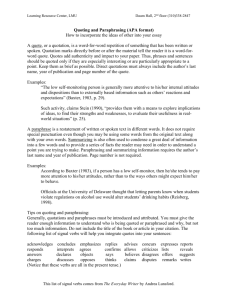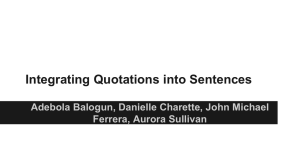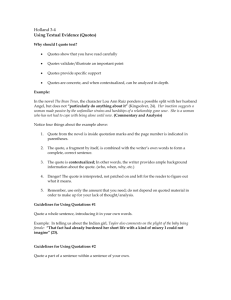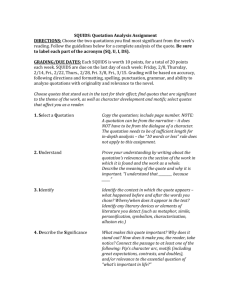How to Choose and Use Quotations
advertisement
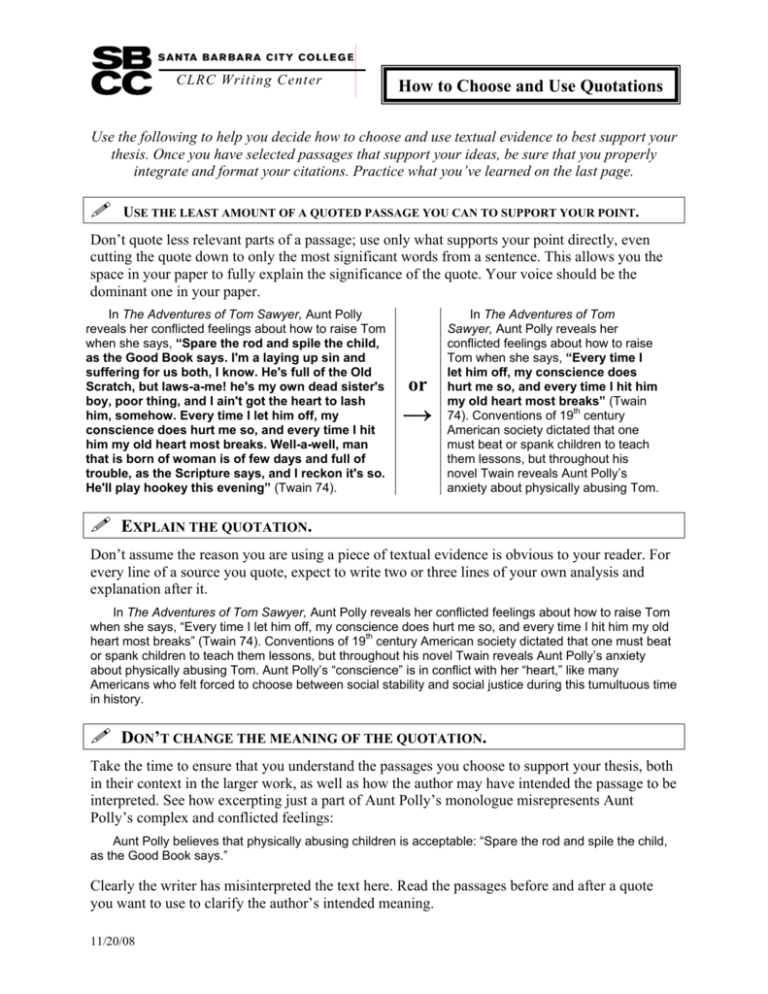
CLRC Writing Center How to Choose and Use Quotations Use the following to help you decide how to choose and use textual evidence to best support your thesis. Once you have selected passages that support your ideas, be sure that you properly integrate and format your citations. Practice what you’ve learned on the last page. USE THE LEAST AMOUNT OF A QUOTED PASSAGE YOU CAN TO SUPPORT YOUR POINT. Don’t quote less relevant parts of a passage; use only what supports your point directly, even cutting the quote down to only the most significant words from a sentence. This allows you the space in your paper to fully explain the significance of the quote. Your voice should be the dominant one in your paper. In The Adventures of Tom Sawyer, Aunt Polly reveals her conflicted feelings about how to raise Tom when she says, “Spare the rod and spile the child, as the Good Book says. I'm a laying up sin and suffering for us both, I know. He's full of the Old Scratch, but laws-a-me! he's my own dead sister's boy, poor thing, and I ain't got the heart to lash him, somehow. Every time I let him off, my conscience does hurt me so, and every time I hit him my old heart most breaks. Well-a-well, man that is born of woman is of few days and full of trouble, as the Scripture says, and I reckon it's so. He'll play hookey this evening” (Twain 74). or → In The Adventures of Tom Sawyer, Aunt Polly reveals her conflicted feelings about how to raise Tom when she says, “Every time I let him off, my conscience does hurt me so, and every time I hit him my old heart most breaks” (Twain 74). Conventions of 19th century American society dictated that one must beat or spank children to teach them lessons, but throughout his novel Twain reveals Aunt Polly’s anxiety about physically abusing Tom. EXPLAIN THE QUOTATION. Don’t assume the reason you are using a piece of textual evidence is obvious to your reader. For every line of a source you quote, expect to write two or three lines of your own analysis and explanation after it. In The Adventures of Tom Sawyer, Aunt Polly reveals her conflicted feelings about how to raise Tom when she says, “Every time I let him off, my conscience does hurt me so, and every time I hit him my old heart most breaks” (Twain 74). Conventions of 19th century American society dictated that one must beat or spank children to teach them lessons, but throughout his novel Twain reveals Aunt Polly’s anxiety about physically abusing Tom. Aunt Polly’s “conscience” is in conflict with her “heart,” like many Americans who felt forced to choose between social stability and social justice during this tumultuous time in history. DON’T CHANGE THE MEANING OF THE QUOTATION. Take the time to ensure that you understand the passages you choose to support your thesis, both in their context in the larger work, as well as how the author may have intended the passage to be interpreted. See how excerpting just a part of Aunt Polly’s monologue misrepresents Aunt Polly’s complex and conflicted feelings: Aunt Polly believes that physically abusing children is acceptable: “Spare the rod and spile the child, as the Good Book says.” Clearly the writer has misinterpreted the text here. Read the passages before and after a quote you want to use to clarify the author’s intended meaning. 11/20/08 2 Integrating Quotations into Your Paper A student must consider what type of essay she is being asked to write and choose appropriate reporting verbs to introduce another author’s words in her essay. CHOOSING REPORTING VERBS: Objective or subjective analysis? Determine whether your assignment is asking you to be informative (objective) or persuasive (subjective) and independently, or with a tutor, decide which reporting verbs might be most appropriate to use when quoting another author: Circle three verbs that you could use to report an author’s words, neutrally. Underline three verbs that offer an opinion about an author’s words. acknowledges* cautions continues addresses charges criticizes adds claims admits explains notes remarks expresses objects replies critiques finds observes reports clarifies declares grants offers responds advises compares demonstrates identifies opposes reveals agrees complains describes illustrates points out says analyzes concedes determines implies posits shows announces concludes disagrees indicates postulates specifies answers concurs discusses insists presents states argues confirms disputes interprets proposes suggests asks considers elaborates introduces raises thinks asserts contends emphasizes maintains refutes translates believes contests examines mentions rejects writes * MLA convention requires that you write in present tense, but students should always confirm expectations with their instructors. USING VERBS: Integrating Quotations Sentence format Introductory phrase with a colon: “…” (Matis 104). Using an introductory phrase and comma, “…” (Jones 23). Using phrases to “complete the sentence” (Cruz 17). (see page 3, section 1 for additional examples) Objective • • • • Subjective Influenced by extensive research, scientists agree that the theory holds true so far: “…” (Mungawa et.al 7). McGain asserts, “…” (222). “…,” Barber observes (56). • Garcia criticizes Lelands’s logic: “…” (para. 12). • Always the gentlewoman, Barret only implies her opponent’s idiocy when she cautions, “…” (118). Elia claims no impartiality and agrees he is “not the right person to make this decision.” • Brown obstinately believes that “all errors of this type are unacceptable.” 3 Properly Formatting Quotations in MLA Format Once you have selected quotes that support your ideas, proper citation of their sources is important in order to avoid plagiarism or misrepresentation of information. The following examples are excerpted from the MLA Handbook for Writers of Research Papers (6th ed.), section 3.7. INTEGRATING QUOTATIONS Quotes need to be integrated into your own writing. Here are three ways to incorporate quotes: • Shelley held a bold view: “Poets are the unacknowledged legislators of the World” (794). • Shelley thought poets “the unacknowledged legislators of the World” (794). • “Poets,” according to Shelley, “are the unacknowledged legislators of the World” (794). BLOCK QUOTATIONS Use “block quotes” if the quote you are using runs more than four lines in your paper. Block quotes are introduced with a colon, each line is indented two tabs’ length, and the quote does not require quotation marks. The parenthetical reference is included at the end, outside of the final punctuation: At the conclusion of Lord of the Flies, Ralph and the other boys realize the horror of their actions: The tears began to flow and sobs shook him. He gave himself up to the now for the first time on the island; great, shuddering spasms of grief that seemed to wrench his whole body. His voice rose under the black smoke before the burning wreckage of the island; and infected by that emotion, the other little boys began to shake and sob too. (186) SPECIAL PUNCTUATION If the quote includes question or exclamation marks used by the author, include that special punctuation, but maintain the capitalization, lower case letters and periods of your own writing: • “How can I describe my emotions at this catastrophe. . . ?” wonders the doctor in Mary Shelley’s Frankenstein (42). • Dorothea Brooke responds to her sister, “What a wonderful little almanac you are, Celia!” (7). If you, as the writer, choose to use special punctuation to comment on a passage you are quoting, the special punctuation will fall outside of the quotation marks. • He attacked “taxation without representation” (32). • Did he attack “taxation without representation”? • What dramatic events followed his attack on “taxation without representation” (32)! QUOTATIONS WITHIN QUOTATIONS Use single quotation marks to indicate quoted dialog or text within a passage you are quoting: • “Read ‘Kubla Khan,’” he told me. EDITING QUOTATIONS If you remove words from a quote that you cite,* replace those words with an ellipsis: three periods with a space between each ( . . . ). If the ellipsis falls at the end of a quotation, omit the first space. • • In surveying responses to plagues in the Middle Ages, Barbara W. Tuchman writes, “Medical thinking … stressed air as the communicator of disease, ignoring sanitation or visible carriers” (101-02). In surveying responses to plagues in the Middle Ages, Barbara W. Tuchman writes, “Medical thinking, trapped in the theory of astral influences, stressed air as the communicator of disease. . . ” (101-02). * If you edit an author’s words, be sure that you honestly represent the author’s ideas, and maintain correct grammar. 4 Practice Choosing and Using Quotations Complete the following worksheet, either independently or with a tutor, to determine whether you have chosen and used quotations correctly. Choosing Quotations 1. Is any part of the lines or passage you have chosen unrelated to the point you wish to support with the quote? Use the chart below to match the textual evidence you have chosen to use with the point you plan to make. Be sure to fully explain the significance of the whole quote to your greater idea (your thesis). Eliminate any unnecessary words or sentences from the quote. Quote Analysis How does the quote relate to your thesis? Hint: Plan to write 2-3 sentences of your own analysis for each line of another author’s words you quote. Using Quotations: Integrating quotes into your paper 2. Is your assignment asking you to be informative or persuasive? Check the appropriate box below and record the reporting verbs from the corresponding group that you selected on page two of this handout: Informative (objective) Your assignment sheet might contain some of the following words: “Explain,” “inform,” “present,” “report,” “summarize,” or “restate”. Persuasive (subjective) Your assignment sheet might contain some of the following words: “Argue”, “take a position,” “evaluate,” “analyze,” or “synthesize”. Appropriate reporting verbs: 1. 2. 3. Any others? 3. Based on the type of essay you are writing, have you introduced your quotations with appropriate verbs that are either neutral (objective) or critique (subjective) the positions of the authors? Using Quotations: Formatting and punctuating quotes 4. Now that you have appropriate quotes integrated into your paper: Cover the quotation marks around the quote and read your sentence aloud. Does it read like a grammatically correct sentence with a verb for each subject, and coordinated clauses? Check to make sure your end punctuation is outside of the final parenthesis. ; Meet with a tutor or your instructor, if you have additional questions.
